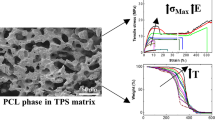Abstract
Starch has been considered as an attractive biopolymer because of its low cost, low density, and biodegradability. However, its poor compatibility with other polymers is drawback, and many researches were performed to overcome this in the polymer blends. Gelatinization, a technique to enhance miscibility among polymers, has been intensively studied due to its better processability than starch. Poly (Butylene Succinate) (PBS) is one of the promising biodegradable polymers due to its excellent mechanical properties and processability, but the softness, flexibility, and relatively high cost also give a limitation for various industrial applications. Blending with low-price resins become an alternative approach to resolve those problems to improve mutual physical properties. Recently, biopolymers derived from renewable resources have received much attention to manufacture the biodegradable blends. This study was performed to examine in depth the effect of starch and gelatinized starch on the physical and mechanical properties of PBS/ starch binary blends. It was confirmed that PBS/TPS blends were immiscible having poor compatibility. 30 phr of glycerol had relatively more gelatinization effect, and the mechanical property of PBS/TPS blend became poor as the content of TPS increased. Furthermore, PBS/GTPS blends were better than PBS/EGTPS in the mechanical property due to plasticization degree.
Similar content being viewed by others
References
Averous, L., “Biodegradable Multiphase Systems Based on Plasticized Starch: A Review,” Journal of Macromolecular Science, Part C: Polymer Reviews, Vol. 44, No. 3, pp. 231–274, 2004.
Ma, X.-F., Yu, J., and Wan, J. J., “Urea and Ethanolamine as a Mixed Plasticizer for Thermoplastic Starch,” Carbohydr Polymers, Vol. 64, No. 2, pp. 267–273, 2006.
Vassiliou, A., Chrissafis, K., and Bikiaris D., “In Situ Prepared PBSu/ SiO2 Nanocomposites. Study of Thermal Degradation Mechanism,” Thermochimica Acta, Vol. 495, No. 1, pp. 120–128, 2009.
Lee, J. Y., Kim, J. M., and Cho, D. H., “Fiber Loading Effect on the Interlaminar, Mechanical, and Thermal Properties of Novel Lyocell / Poly (Butylene Succinate) Biocomposites,” Journal of Adhesion and Interface, Vol. 10, No. 2, pp. 106–112, 2009.
Lee, S. M., Cho, D., Park, W. H., Lee, S. G., Han, S. O., et al., “Novel Silk / Poly (Butylene Succinate) Biocomposites: The Effect of Short Fibre Content on Their Mechanical and Thermal Properties,” Composites Science and Technology, Vol. 65, No. 3, pp. 647–657, 2005.
Han, S. O., Lee, S. M., Park, W. H., and Cho, D., “Mechanical and Thermal Properties of Waste Silk Fiber Reinforced Poly (Butylene Succinate) Biocomposites,” Journal of Applied Polymer Science, Vol. 100, No. 6, pp. 4972–4980, 2006.
Zullo, R. and Iannace, S., “The Effect of Different Starch Sources and Plasticizers on Film Blowing of Thermoplastic Starch: Correlation among Process, Elongational Properties and Macromolecular Structure,” Carbohydrate Polymers, Vol. 77, No. 2, pp. 376–383, 2009.
Lim, S. T., Hyun, Y. H., Choi, H. J., and Jhon, M. S., “Synthetic Biodegradable Aliphatic Polyester / Montmorillonite Nanocomposites,” Chemistry of Materials, Vol. 14, No. 4, pp. 1839–1844, 2002.
Kim, J. H., Lim, S. T., Choi, H. J., and Jhon, M. S., “Rheological and Mechanical Characterization of Biodegradable Aliphatic Polyester and Poly (Epichlorohydrin) Blends,” Macromolecular Chemistry and Physics, Vol. 202, No. 12, pp. 2634–2640, 2001.
Lourdin, D., Coiginard, L., Bizot, H., and Colonna, P., “Influence of Equilibrium Relative Humidity and Plasticizer Concentration on the Water Content and Glass Transition of Starch Materials,” Polymer, Vol. 38, No. 21, pp. 5401–5406, 1977.
Lai, S. M., Huang, C. K., and Shen, H. F., “Preparation and Properties of Biodegradable Poly (Butylene Succinate) / Starch Blends,” Journal of Applied Polymer Science, Vol. 97, No. 1, pp. 257–264, 2005.
Ma, X. and Yu, J., “The Effect of Plasticizers Containing Amide Groups on the Properties of Thermoplastic Starch,” Starch Stärke Vol. 56, No. 11, pp. 545–551, 2004.
Ma, X. and Yu, J., “Formamide as the Plasticizer for Thermoplastic Starch,” Journal of Applied Polymer Science, Vol. 93, No. 4, pp. 1769–1773, 2004.
Pawlak, A. and Mucha, M., “Thermogravimetric and FTIR Studies of Chitosan Blends,” Thermochimica Acta, Vol. 396, No. 1, pp. 153–166, 2003.
Chung, H.-J., Woo, K.-S., and Lim, S.-T., “Glass Transition and Enthalpy Relaxation of Cross-Linked Corn Starches,” Carbohydr Polymers, Vol. 55, No. 1, pp. 9–15, 2004.
Liu, P., Yu, L., Liu, H., Chen, L., and Li, L., “Glass Transition Temperature of Starch Studied by a High-Speed DSC,” Carbohydrate Polymers, Vol. 77, No. 2, pp. 250–253, 2009.
Stepto, R. F. T., “Thermoplastic Starch,” Macromolecular Symposia, Vol. 152, No. 1, pp. 73–82, 2000.
Da Roz, A., Carvalho, A., Gandini, A., and Curvelo, A., “The Effect of Plasticizers on Thermoplastic Starch Compositions Obtained by Melt Processing,” Carbohydrate Polymers, Vol. 63, No. 3, pp. 417–424, 2006.
Córdoba, A., Cuéllar, N., González, M., and Medina, J., “The Plasticizing Effect of Alginate on the Thermoplastic Starch/Glycerin Blends,” Carbohydrate Polymers, Vol. 73, No. 3, pp. 409–416, 2008.
Ratto, J. A., Stenhouse, P. J., Auerbach, M., Mitchell, J., and Farrell, R., “Processing, Performance and Biodegradability of a Thermoplastic Aliphatic Polyester / Starch System,” Polymer, Vol. 40, No. 24, pp. 6777–6788, 1999.
Park, J. W., Im, S. S., Kim, S. H., and Kim, Y. H., “Biodegradable Polymer Blends of Poly (L-Lactic Acid) and Gelatinized Starch,” Polymer Engineering & Science, Vol. 40, No. 12, pp. 2539–2550, 2000.
Moates, G., Noel, T., Parker, R., and Ring, S. G., “Dynamic Mechanical and Dioelectric Characterization of Amylose-Glycerol Films,” Carbohydrate Polymers, Vol. 44, No. 3, pp. 247–253, 2001.
Author information
Authors and Affiliations
Corresponding author
Rights and permissions
About this article
Cite this article
Yun, I.S., Hwang, S.W., Shim, J.K. et al. A study on the thermal and mechanical properties of poly (butylene succinate)/thermoplastic starch binary blends. Int. J. of Precis. Eng. and Manuf.-Green Tech. 3, 289–296 (2016). https://doi.org/10.1007/s40684-016-0037-z
Received:
Accepted:
Published:
Issue Date:
DOI: https://doi.org/10.1007/s40684-016-0037-z




